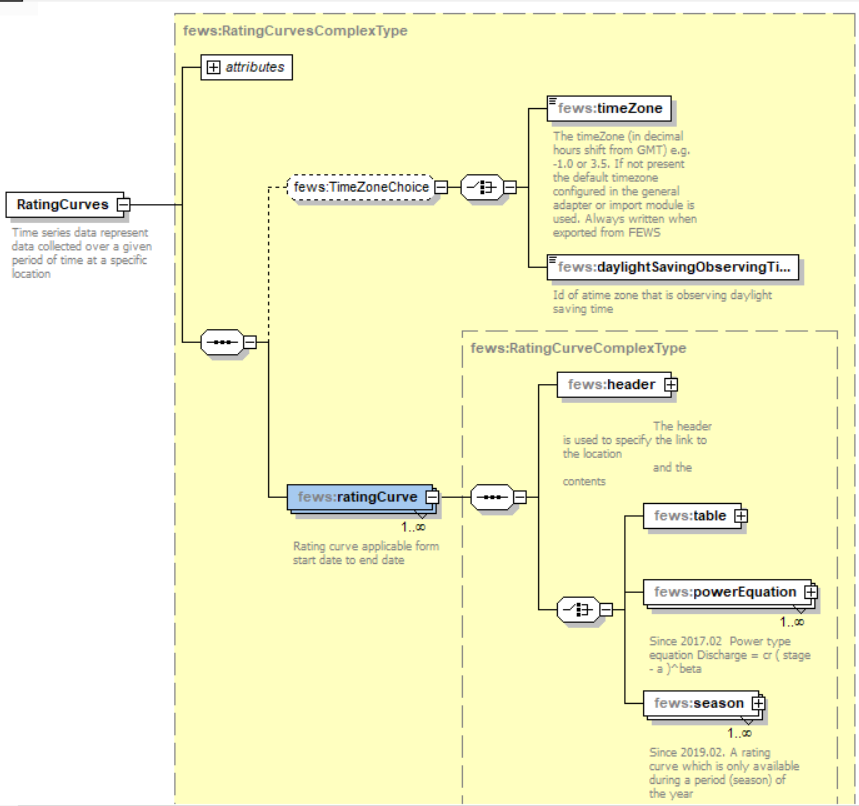...
What | pi |
|---|
_ratingcurves.xml | |
Description | Configuration for rating curves at specific locations |
|---|---|
schema location |
deltares.nl/schemas/version1.0/pi-schemas/pi_ratingcurves.xsd |
Entry in ModuleDescriptors
<description>General transformation Component</description>
</moduleDescriptor>
...
Configuration
The The transformation stageDischarge/ratingCurve uses rating curves according to the schema pi-_ratingcurves.xsd. It is possible to store the ratingcurves in a ratingCurves.xml file in the regionConfig directory. However it is recommended to store
Rating curves can be stored in the folder RegionConfigFiles in the file RegionConfig.xml , or can be imported in the FEWS database with TimeSeriesImport module, import type “pi_ratingcurves”the ratingCurves to the FEWS database. The ratingCurves can be imported in the FEWS database by using a dedicated import which is capable of importing rating curves from file as long as the file is compliant with the pi-ratingCurves.xsd schema.
Rating Curve schema
Below an overview of the The schema of the pi-ratingcurves can be found at: https://fewsdocs.deltares.nl/schemas/version1.0/pi-schemas/pi_ratingcurves.xsd
Header
The header element contains the metadata about the rating curve. Below an overview of the available elements.
- locationId
...
- : The location id for which the rating curve is valid
- qualifierId
...
- : The allows the configurator to add 1 or more qualifier to the definition of the rating curve. This is useful when for 1 location more rating curves are valid.
...
- The locationId and the configured qualifiers define the id of the rating curve.
- startDate
...
- : This element defines when the rating curve becomes active.
- endDate
...
- : This (optional) element defines until when the rating curve is active.
- longName
...
- : Optional descriptive name
- stationName
...
- : Optional station name
- stageUnit
...
- : Definition of the stage unit
- dischargeUnit
...
- : Definition of the discharge unit
- comment
...
- : This section allows to define a (optional comment) for the rating curve. If a comment is defined the comment will be shown in the TimeSeriesDialog when viewing the rating curve.
- creationDate
...
- : The date on which the rating curve was created.
- creationTime
...
- : The time on which the rating curve was created.
- region
...
- : The description of the region. This is needed when the id of the rating curve is the same in different regions.
- properties: Optional properties of the rating curve
Table
The table contains the actual description of the Table rating curve.
- InterpolationMethod
...
- : Two options are available:linear and logaritmic. When linear is selected the calculation is done by the regular linear method.
The slope will be computed as:
THe The discharge can be calcuted from the stage by using the following equation:
...
This option is usually used to limit the stage value calculated when using extrapolation.
maxStage
The maximum stage which is allowed for this rating curve.
...
If a row doesn't include an offset element then the previous defined offset will be used.
...
powerEquation (Since 2018.02)
PowerEquation can be used as PI Rating cuve since Delft-FEWS version 2018.02.
The powerEquation uses the following equations:
discharge = cr * (stage - alpha)^ beta + Q0
stage = (discharge/cr)^(1/beta) + alpha
where ‘cr’ and ‘beta’ are rating curve constants, ‘alpha’ is a constant which represents the stage corresponding to zero discharge and Q0 is optional shifting constant.
To show the stageToDischargePowerEquation rating curves in the TimeSeriesDisplay, a table is generated on the fly from the power equations.
For each equation ten stage values are generated using increment (max stage – min stage) /10 , and for each stage a discharge is computed. Please note that this table is only used in the display and not in TransformationModule computations.
...


